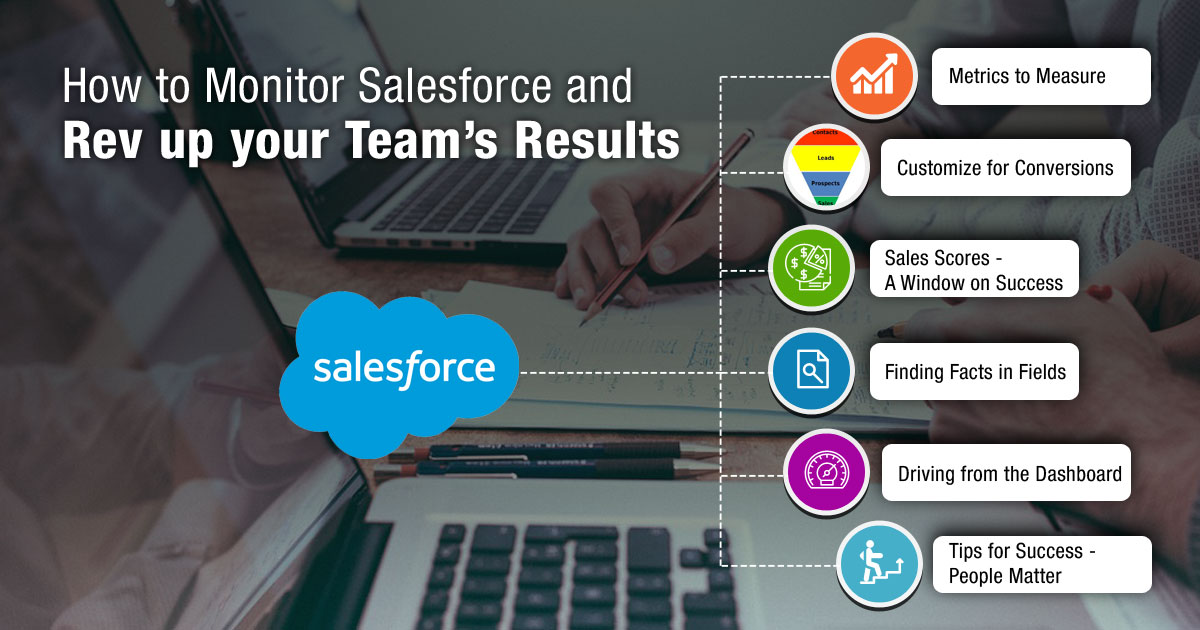Salesforce gives you x-ray vision into the productivity of your sales professionals on everything from the number of cold calls they make, to how often they sit face-to-face with a prospect or customer. With an inside view of the activities that maximize results, you can optimize your sales machine.

Metrics to Measure
For you to turbocharge a sales organization using Salesforce implementation, it is critical to measure a range of sales metrics that span all the stages of the sales process, from lead generation to post-purchase. These measures are useful for informed decision-making, sales tactics optimization, and in the long run, for the increased performance of sales. Here's a view of the sales funnel and post-purchase analysis:
# Lead Generation and Qualification
- MQL to SQL Conversion Rate: Measures the efficiency in converting marketing qualified leads (MQL) to sales qualified leads (SQL), crucial for understanding the effectiveness of your lead generation efforts.
- Lead Response Time: Shows how fast your sales team reacts on leads that influences directly the conversion rates.
# Sales Process and Pipeline Management
- Demo and Proposal Metrics: Count the number of demos to be scheduled, average time used to create proposals and feedback follow-ups. These metrics provide a way of measuring the productivity and performance of the sales process.
- Conversion Rate: This indicator helps to determine the efficiency of sales activities and strategies.
- Negotiation and Closing
- Revisions Requested and Average Discount Required: Proposals revisions and average discount required to close a deal are performance metrics that give details of the effectiveness of the negotiation phase.
- Add-Ons and Upsells Secured: Revenue is to a great extent affected by the measurement of selling of additional products or services to the existing customers.
# Customer Retention and Value
- Customer Lifetime Value (CLV): Quantifies the overall value that a customer is expected to have to the company over the life thus, highlights the necessity of customer retention and relationship management.
- Customer Retention/Churn Rate: Evaluates the health of customer relationships by the retention rate over a certain period alongside those that churned.
# Financial Metrics and Growth Analysis
- Customer Acquisition Cost (CAC): The customer acquisition cost, which is one of the dimensions to look at when measuring the return on investment of your sales and marketing strategies.
- Sales Growth and Total Revenue: The above metrics offer a broad picture about financial prognosis and growth vector of your sales organization.
# Additional Considerations
- Employee Retention/Churn: The impact of sales representatives on the levels of sales is significant and thus, in order to get some information on the wellbeing of your organization and operational stability, you are supposed to track the level of your staff retention and churn rates.
- Net Promoter Score (NPS): NPS represents customer loyalty and satisfaction and it is a way to know the overall customer sentiments towards your organization.
Customize for Conversions
Salesforce customization for conversions is a holistic process of ensuring effective sales funnel management. The analysis of the customer journey from the initial awareness through to the purchase and advocacy stage will help to identify the areas for optimization and the success benchmarks.
# Stages and Optimization of Sales Funnel
- Awareness to Purchase: The process begins with the consumer being informed of your product and ends with a sale. Proper control of this process is based on identification and the use of some unique features of the product or the service, application of ecommerce and CRM technologies aimed at directing a client toward a purchase and development of the advocacy post-purchase through a good customer service and an effective social media interaction.
- Conversion Funnel Optimization: Among the ways to optimize the conversion funnel are sending focused incentives, giving prominence to email marketing as the most efficient in customer acquisition, offering custom pricing and creating strong calls to action. Successful is a result of the absence of common pitfalls such as lack of customer recognition and the early rejection of the marketing methods.
# Tailoring Salesforce for Better Analysis
- Dashboard and Reporting: Salesforce Solution allows you to open specific dashboards or reports, such as your Sales Overview, and customize them for a more detailed look at your data, including funnel visualization. This high-level overview can be further enhanced with detailed funnel views and calculations within Salesforce.
- Using Spreadsheets for Analysis: For a more granular analysis, leveraging spreadsheets to manage and visualize your sales data can be more effective. This approach allows for a clear understanding of your sales process and the identification of potential opportunities. Tools like Coefficient can automate the reporting process from multiple systems, allowing for real-time data updates without manual entry.
# Understanding Sales Funnel Conversion
- Analyzing the Customer Journey: Sales funnel analysis enables finding the points of friction throughout the customer journey, which can be fixed by the teams, thereby leading to better customer experience and conversions. Through analysis of different factors including conversion rates, time to conversion, as well as user behavior at each stage, businesses are able to identify the areas for product enhancement and marketing optimization.
- Behavioral Criteria for Funnel Stages: Establishing clear criteria based on prospect behavior for moving through each funnel stage is crucial. This involves setting specific, actionable guidelines that help in guiding prospects successfully from awareness to purchase.
# Key Metrics and KPIs to Track
- Sales Qualified Leads (SQLs) and New Customers: Monitoring the MQLs to SQLs transition and the achievement of SQLs in new customers gives visibility into the lead qualification process and the sales strategies tendency
- Opportunity Win Rate and Conversion Rate: These measures make it possible to evaluate the performance of your sales team on a lead conversion level, as well as the overall productivity of your sales process. Identifying where leads drop off and running A/B tests can optimize conversion strategies.
- Expected Revenue, Amount Won, and Lost: Tracking expected revenue, the total revenue generated from closed deals, and analyzing lost opportunities can inform strategic adjustments and focus areas for your sales team.
Sales Scores – A Window on Success
Because Salesforce enables you to score your salespeople on each of the activities they conduct, it becomes a diagnostic tool that measures the health of your sales organization for each of your sales representatives.
After you have learned the magnitude of the productivity of each of the activities that your sales organization practices, you can grade each of them. Assuming, for instance that sitting in front of a prospect is ten times more productive than a phone call. Alternatively, the call to a hot lead is ten times more likely to close than a cold call. You can score each of your sale force’s activities according to their effectiveness. Then you give each sales rep a score based on the activities he or she completes during a defined period.
Finding Facts in Fields
You’ll be capturing each piece of data in Salesforce, such as a date, last name and lead source, in a field. So anytime a field is changed it means there has been some activity. Monitoring and reporting field history is an excellent way to measure user activity because users don’t have to report what they’ve been up to.
Of course, this requires that sales people enter the essential information into fields. To assure this happens, set up Salesforce so a user cannot leave a screen until they have entered all the required fields.
Driving from the Dashboard
Assemble this data into your Salesforce dashboard, where you can look at the big picture. For instance, review the ratings of your sales reps in order to determine who is lagging behind and who is leading. After which, you are just a few clicks or so away from delving deeply into the nitty-gritty of a sales rep’s activities. This data enables you to see who needs coaching, or, if all else fails, to identify dead wood that needs to be pruned.
In addition, coupling the activity scores with sales results can act as a motivational tool for sales people. It’s evidence in black and white that shows the activities which lead to sales results and fatter commission checks.
Tips for Success – People Matter
Success in Salesforce implementation is beyond the software and lies in the people who use it. It is important to make sure that your sales team not only is proficient in working with Salesforce, but also understands the importance of the accurate data input. This intelligence is critical in using the capabilities of Salesforce to achieve sales and customer relationship improvements.
Training is a key component of this process. It's not just about showing your team how to use the software; it's about embedding the understanding of why diligent data entry in Salesforce is directly linked to their success. By correlating the act of using Salesforce with achieving their sales targets and improving customer engagement, you instill a sense of importance and motivation towards regular and precise use of the system.
Recognizing that sales teams are often on the go, flexibility and accessibility become critical. To accommodate this need, integrating mobile solutions allows your team to update Salesforce from any location, at any time. Telephony integration apps are invaluable tools in this regard. They empower sales personnel to log calls and activities directly into Salesforce without being tethered to a desk. For instance, utilizing a free application like Sales Logger on an iPhone enables immediate data logging, ensuring no customer interaction goes unrecorded.
These apps not only facilitate ease of use but also ensure that the data in Salesforce remains current and reflective of the latest customer interactions. This real-time data is instrumental in making informed sales decisions, forecasting accurately, and delivering personalized customer experiences.
Call us at 484-892-5713 or Contact Us today to know more details about how to monitor SalesForce and Rev Up your team’s results.


